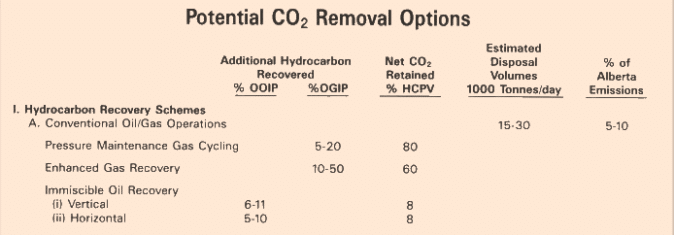This April 1991 document from Imperial Oil Ltd, the Canadian subsidiary of Exxon, is a report on “Underground Disposal of Carbon Dioxide.” This document is part of the ClimateFiles Imperial Oil document set, gleaned by DeSmog researchers from the Glenbow Imperial Oil Archive Collection.
This report is part of a series of research papers produced by Imperial as part of the “seven point work program” to “further understand the implications of potential global warming” laid out in their March 1990 position paper on “Potential Global Warming.” This document fulfills the fourth point in that work plan: a commitment “to determine the technical and economic potential for carbon dioxide ‘sinks’, or mechanisms to remove carbon dioxide from the atmosphere, such as underground injection into oil bearing reservoirs to support enhanced oil recovery operations.” Some of Imperial’s other papers addressing points on their work plan include its 1991 Preliminary Inventory of Greenhouse Gas Emissions and a 1991 report on Potential for CO2 Reductions from Additional Energy Efficiency.
Imperial states their commitment to “Participating in the public policy debate concerning the issue of global climate change, given their role “as a significant Canadian producer, marketer and consumer of fossil fuels.” The study in this document “focuses on CO2 emission sources in Alberta…emissions from these facilities are about 142,000 tonnes per day – about 42 percent of Alberta CO2 emissions and 10 percent of the Canadian total.” By Imperial’s estimates in this study, “it would be technically feasible to develop, over a five to 10 year period, the infrastructure to permanently dispose of up to 50,000 tonnes per day of CO2.”
The capital investment required to make these reductions is estimated by Imperial at “approximately $7.5 billion” in order to reduce atmospheric emissions “by about 50,000 tonnes per day (about 15 percent of the Alberta CO2 emissions).” Given these costs and the relative efficiency of underground CO2 disposal, Imperial finds that such an undertaking does not “appear to be economic” and would “achieve a relatively minor impact in reducing CO2 emissions” even with significant collaboration among stakeholders. While the report doesn’t find underground CO2 disposal to be an economically viable option for Imperial alone, the paper does conclude that such strategies may “require further technical and cost assessment” in the event that “international strategies evolve to reduce CO2 and other greenhouse gas emissions through steps that are uneconomic in their own right.”


